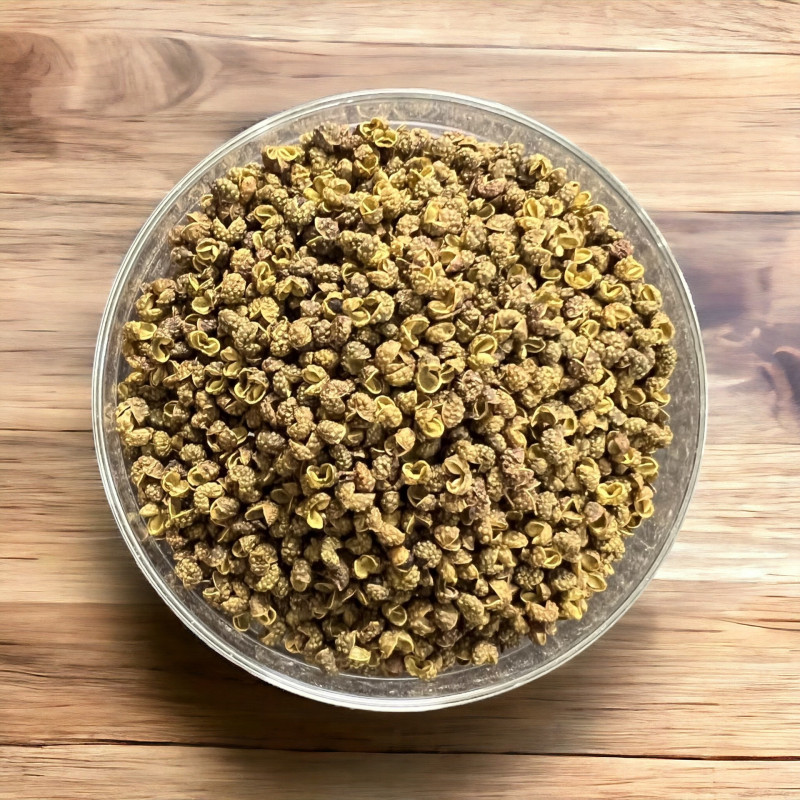
Reference: poivresichuanE


This pepper (which isn’t really a pepper!) will surprise you with its intensity, its tingling sensation on the tongue, and especially its powerful citrus aroma...!
Ground or infused, it pairs excellently with fish and shellfish, duck, and even with ice cream and chocolate!
 Delivery
Delivery
Mondial Relay
 Returns
Returns
See conditions
 Payments
Payments
100% secure
Livré en sachet refermable
Uses in Cooking:
Often referred to as "green fagara," the first thing that surprises is the emerald green color of green Sichuan pepper. Next, the nose is overwhelmed by its aroma, a blend of citrus, lemongrass, and chopped herbs. Finally, the taste astounds with its intensity, mixed with citrus notes, lime, and a beautiful lingering finish! It also has the same strange tingling sensation as its more mature brother, Sichuan pepper, even more pronounced.
Its nickname "Sansho pepper" comes from its resemblance to the Japanese seed of the same name, which has a very similar flavor but is much, much more expensive! So if you were looking for "Sansho," give this "green fagara" a try; you won't be disappointed!
You can lightly toast it in a pan before grinding it into powder, or simply pass it through a mill just before consuming. It is magical with fish, shellfish (notably scallops), and absolutely extraordinary with duck. It will add a unique twist to a fruit salad and elevate a chocolate dessert or ice cream! You can also pair it with a sprinkle of fleur de sel added at the last moment to your dish.
As with many spices, if you want to add it during the cooking process, it’s best to do so halfway through cooking to avoid altering its flavor too much with heat. Finally, if you don’t want your dish to be too intense for your taste, use it sparingly!
Sichuan pepper is also widely used in Tibetan cuisine, as it is one of the few spices that can grow at high altitudes, as well as in Japan.
Who am I?
Origin: China
Scientific name: Zanthoxylum bungeanum
Other names: Green fagara, Chinese pepper, flower pepper, clavalier, Sancho pepper
Sichuan pepper, whether green or more mature, is named after the province in China from which it originates. Despite its name "pepper," it is not related to true pepper but rather belongs to the citrus family!
The Sichuan pepper tree is a deciduous shrub of the Rutaceae family, reaching about 2.5 meters in height. In autumn, its foliage takes on stunning mauve and purple hues. The undersides of the deeply divided and aromatic leaves, along with the branches, are covered with many sharp thorns reminiscent of those on roses. It produces small, bumpy fruits a few millimeters in diameter that gradually change from green to dark violet at full maturity in October.
In fact, only the empty husk of these small fruits is consumed, which split open after drying to release the shiny black seed they contain, which is removed because it is hard and somewhat bitter. A good Sichuan pepper should contain a maximum of empty husks and as few seeds as possible!
A Little History:
Sichuan pepper has been cultivated in China and Japan since ancient times. This shrub was discovered, and its fruits were brought to Venice by Marco Polo in the 13th century. At that time, it became a sensation in Venetian cuisine. It then disappeared until the 19th century when it was rediscovered by curious botanists who named it "clavalier." It is only in recent years that culinary curiosity has brought it back into vogue!
Data sheet
Specific References
Reference: poivresichuanE
Reference: 508207101
Reference: pondichery
Reference: poivresichuanE
Reference: 508207101
Reference: 2M6273801
Reference: Graineparadis
Reference: 208029701
Reference: 6L5609802
Reference: poivreNEvietnam
Reference: 9N7644901
Reference: poivreBEviet
Reference: poivrevoatsE
Reference: SriLankaBlanc
Reference: 6N745801
Reference: Kubebe

This pepper (which isn’t really a pepper!) will surprise you with its intensity, its tingling sensation on the tongue, and especially its powerful citrus aroma...!
Ground or infused, it pairs excellently with fish and shellfish, duck, and even with ice cream and chocolate!